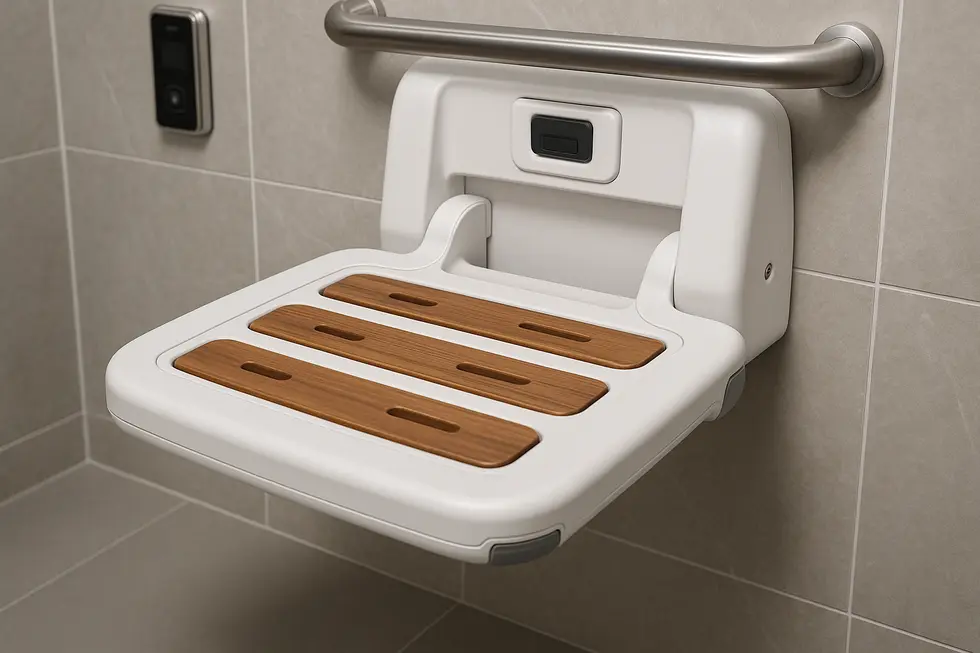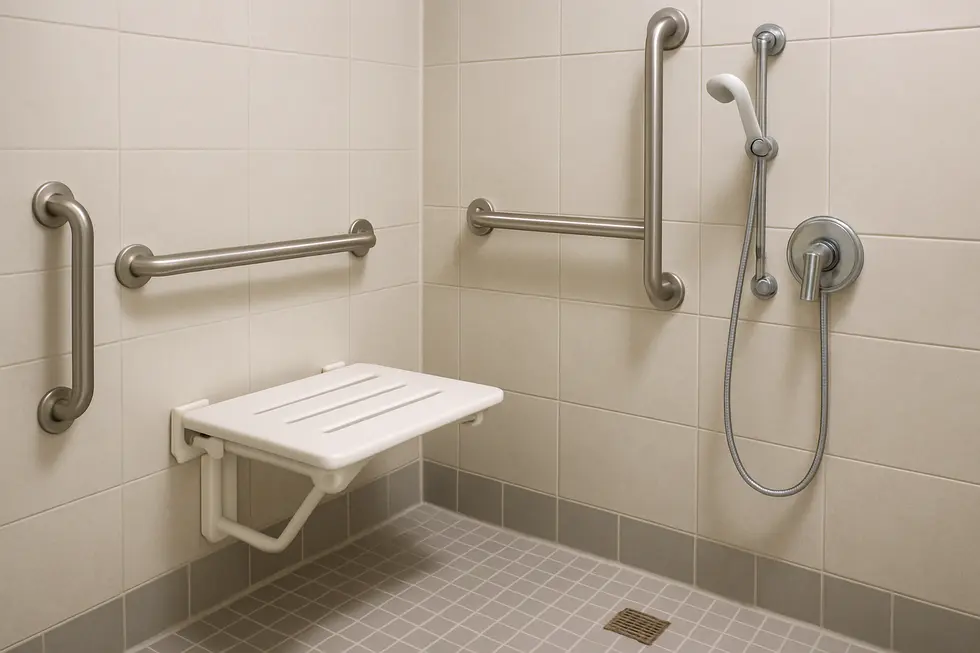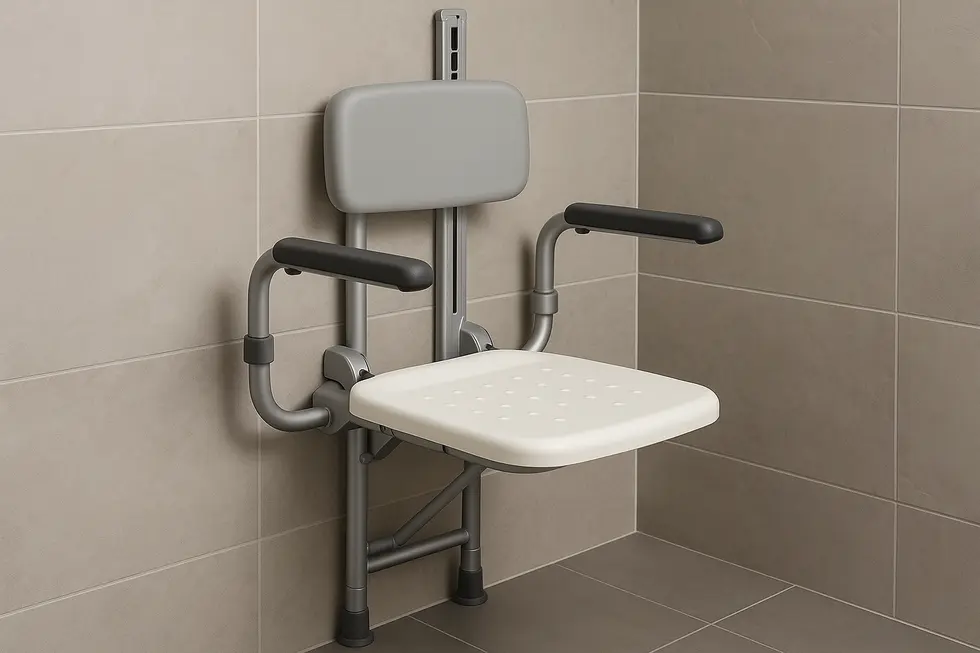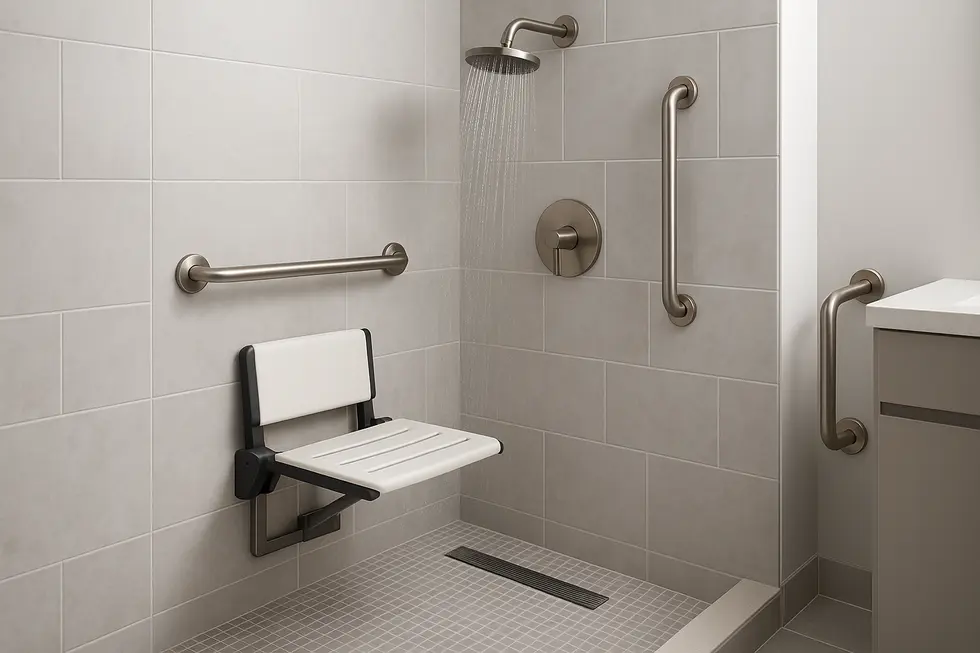Shower Seat
Innovative Designs in Hospital Wall Mounted Shower Seats
Hospital wall mounted shower seats are redefining safety, accessibility, and hygiene in healthcare environments. In this article, we explore the latest innovative designs that combine engineering precision with user-centric functionality – all optimized to meet ADA compliance and hospital-grade durability.
Engineering Comfort and Safety: The New Science Behind Hospital Wall-Mounted Shower Seats

Ask any facilities manager why the hospital bathroom remains a high-risk zone: slipping and cramped layouts. Modern wall-mounted shower seats counter both through precise engineering and advanced materials. A slim stainless-steel frame now supports far beyond ADA minimums yet folds flatter than a closed notebook, instantly freeing turning space for wheelchairs and gurneys.
Folding hardware has evolved from creaky hinges to gas-assisted struts and concealed torsion springs, letting the seat glide up with two fingers. Mounting brackets are laser-cut for exact alignment with wall studs, eliminating the unnerving side-to-side wobble that once plagued earlier units. Some designs integrate colored position indicators so staff can confirm full lock engagement at a glance, an important visual cue during hurried morning rounds.
Traction and hygiene share top billing on the seat surface. Molded phenolic resin is etched with micro-textures that wick water away while amplifying grip. Rounded drainage slots prevent pressure points, and edge chamfers ensure clothing or catheter lines slide clear. Polymer composites that emulate teak offer a warm feel without the microbial risks of real wood. Antimicrobial additives baked into the resin disrupt bacterial cell walls, allowing maintenance teams to sanitize quickly with standard hospital cleaners instead of harsh chemicals.
Ergonomics guide every curve. An eighteen-inch seat height places knees just above hip level, reducing effort when standing. Pivoting arm supports swing clear for transfers, and bariatric versions widen the same geometry for heavier users. Height adjustments in two-inch increments are available for pediatric wings, using concealed pin systems that resist tampering. For deeper insight, see this analysis of a folding wall-mounted shower seat design.
Before approval, prototypes endure thousands of load cycles while disinfectants spray continuously, proving corrosion resistance and hinge resilience. Routine maintenance schedules have shrunk because bushings are now self-lubricating polymers that shrug off soap scum. Even after repeated impact testing, these components maintain smooth motion without squeaks that could startle nervous patients. The survivors deliver a dignified bathing experience, marrying corrosion-proof alloys, self-draining phenolics, and silent kinematics. Technical data exemplifying these standards is available in the manufacturer’s complete technical specifications.
Built for Trust: Safety Standards and ADA Rules Governing Hospital Wall-Mounted Shower Seats

Reliability is non-negotiable when patients entrust a slender fold-down platform with their balance, dignity, and recovery. Every hospital wall-mounted shower seat must therefore earn its place on the tiled wall through rigorous safety testing before a single screw is driven. U.S. standards call for a minimum 300-pound static load rating, but most hospital-grade models are engineered to exceed that threshold. Manufacturers apply progressive weight, abrupt drop tests that mimic a user “plopping” down, and sustained load cycles to expose hidden weak points. Frames crafted from stainless steel or anodized aluminum resist flexing, while marine-grade hinges endure thousands of fold-ups without loosening.
Safety is about more than brute strength. Wet environments demand surfaces that stay grippy when coated with soap film, so subtle textures or molded drainage channels channel water away and keep skin in contact with the seat. Edges are rounded to prevent skin tears, and optional swing-up armrests give lateral support during transfers yet stow neatly to preserve space.
Parallel to laboratory trials, design teams keep an open codebook: the Americans with Disabilities Act. The ADA sets the ground rules for real-world accessibility. Mounting height must land between 17 and 19 inches above the finished floor—high enough for an easy rise yet low enough for wheelchair transfer. Clearance diagrams ensure a mobility device can pivot beside the seat while grab bars remain within fingertip reach. The standard also dictates that hand-held shower wands, soap recesses, and valve controls be operable from a seated position without forcing a user to overreach.
Meeting the letter of the ADA is only step one; forward-thinking facilities involve occupational therapists to position each seat for the particular clientele they serve, adjusting height, adding cushions, or choosing slatted teak battens for faster drying and easier sanitation.
For a deeper dive into practical installation checkpoints, consult these concise safety guidelines for wall-mounted shower seats. Additional technical specifications for ADA-compliant teak models are available through external resources such as the Rehab-Store’s detailed product sheet (https://www.rehab-store.com/p-teakworks4u-ada-compliant-wall-mount-plantation-teak-shower-seat.html).
Designing for Dignity: Ergonomic Use and Code-Safe Installation of Hospital Wall-Mounted Shower Seats

Balancing Comfort and Code Compliance
A hospital wall-mounted shower seat must feel natural for the patient while remaining rock-solid for facilities staff. Designers start with body mechanics. A gentle front curve removes pressure behind the knees, while a slight rear dip discourages forward sliding. Many healthcare models adopt a U-shaped cut-out that frees caregivers to assist with intimate washing without twisting the user’s spine. Textured, non-slip inserts built into the seat surface add friction even when soap film is present, a small detail that sharply reduces shearing injuries and panic slips.
Weight capacity tells another ergonomic story. Hospital guidelines assume dynamic movements—shifting, leaning, even a stumble. For that reason, reputable units test to at least 300 lbs, then add an impact margin. Armrests and backrests further distribute load; when they fold with the seat they disappear, leaving the room open for ambulatory users.
Installation converts all that thoughtful design into real-world safety. The seat’s hinge rail must land on blocking that spans a minimum of three wall studs or an approved plywood backer. Tile, drywall, and waterproof boards alone are never structural; installers drill through them into solid framing and seal every penetration to stop hidden moisture rot. Mounting height is fixed—usually 17–19 inches from finished floor—to meet ADA reach ranges and to let most users plant both feet flat before standing. Equally critical is side clearance: at least 30 inches wide to welcome wheelchairs or a helper standing shoulder-to-shoulder.
Hardware tells a durability tale. Stainless steel grade 304 or higher resists chlorine cleaners, while brass or zinc coatings often pit within months. During commissioning, teams perform a live load test: place a weighted bag equal to 1.5 times the rated capacity on the seat, then jolt it vertically. Any wobble demands rework before first patient use.
For step-by-step blocking diagrams and template placement, this practical guide to installing a wall-mounted shower seat offers helpful visuals. More detailed product specifications—including static and impact test certificates—can be reviewed at the manufacturer’s reference page.
Final thoughts
Hospital wall mounted shower seats represent a pinnacle of design, safety, and ergonomic considerations in bathroom solutions for individuals with mobility challenges. They integrate advanced materials and comply with rigorous safety standards while ensuring user comfort and ease of installation. By prioritizing these elements, they maintain a critical role in homecare and medical environments, offering dignity and enhanced independence to users.
Experience a new standard of clean with PEGABidet—designed for comfort, safety, and independence. Join thousands who trust us to make personal care simple and dignified. Contact us contact@pegabidet.com
About us
PEGABidet is a brand owned by L.A NEXTGEN LLC, based in California. We design intuitive, hygienic, and accessible bathroom solutions that prioritize safety, dignity, and independence. Our mission is to make personal care effortless and empowering for people at every stage of life.

